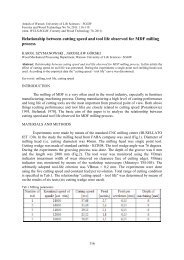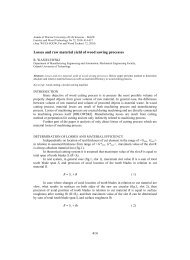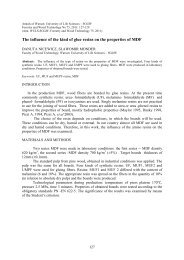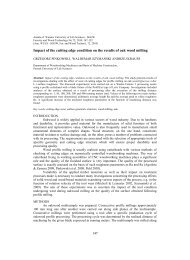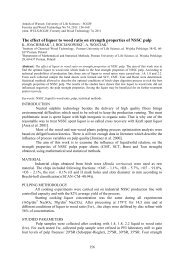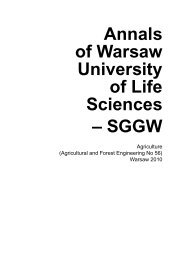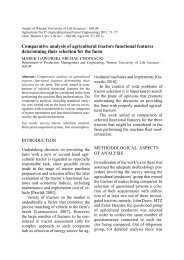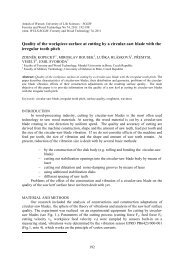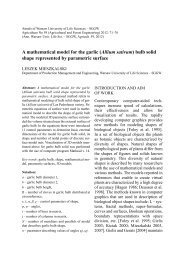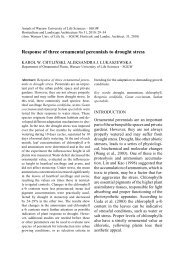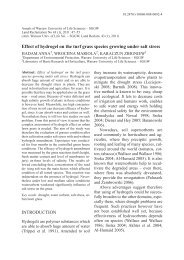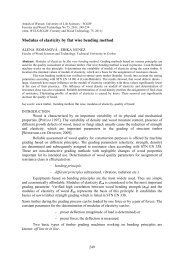Physical-acoustical characteristics of maple wood with wavy structure
Physical-acoustical characteristics of maple wood with wavy structure
Physical-acoustical characteristics of maple wood with wavy structure
Create successful ePaper yourself
Turn your PDF publications into a flip-book with our unique Google optimized e-Paper software.
High-quality <strong>maple</strong> <strong>wood</strong> requires acoustic constant as low as possible, as violin back<br />
plates primarily serve for the reflection <strong>of</strong> sound waves driven by top plates. RAJAN (1998)<br />
reports average values for acoustic constant 6.71 m 4 kg –1 s –1 and 7.94 m 4 kg –1 s –1 for highquality<br />
<strong>maple</strong> <strong>wood</strong> and lower-quality <strong>maple</strong> <strong>wood</strong>. According to POŽGAJ et al. (1997), the<br />
acoustic constant for common <strong>maple</strong> (Acer campestre) <strong>wood</strong> is 5.8 m 4 kg –1 s –1 .<br />
Acoustic impedance, expressing resistance against plane sound waves is determined by<br />
equation<br />
E<br />
Z c<br />
. (3)<br />
<br />
Logarithmic damping decrement is measured experimentally, based on properties <strong>of</strong> forced<br />
oscillations (RAJAN 1998). For <strong>maple</strong> <strong>wood</strong>, the author reports an average value <strong>of</strong> 0.029.<br />
Equations 1–3 show that the discussed acoustic <strong>characteristics</strong> depend on the modulus <strong>of</strong><br />
elasticity E and the density w <strong>of</strong> <strong>wood</strong>. The values <strong>of</strong> the modulus <strong>of</strong> elasticity are influenced<br />
by a range <strong>of</strong> factors (<strong>wood</strong> moisture content, density, <strong>structure</strong>). FABISIAK and MOLISKI<br />
(2007), MOLISKI and KRAUSS (2008) and several other authors suggest that the modulus <strong>of</strong><br />
<strong>wood</strong> elasticity increases proportionally <strong>with</strong> increasing density. In most cases, this relation<br />
has been reported linear. With increasing moisture content <strong>with</strong>in bound water range, the<br />
modulus <strong>of</strong> elasticity decreases. Significant effect on the modulus <strong>of</strong> elasticity results also<br />
from the method used. In general, it holds that the values <strong>of</strong> dynamic modulus <strong>of</strong> elasticity are<br />
higher than the values <strong>of</strong> static modulus <strong>of</strong> elasticity (ROHANOVÁ 2010). It has also been<br />
revealed that different dynamic methods for determining modulus <strong>of</strong> elasticity resulted in<br />
obtaining different values (ROHANOVÁ 2010). There is evidence that comparisons among<br />
modulus <strong>of</strong> elasticity require using the same method.<br />
All discussed physical-acoustic parameters <strong>of</strong> <strong>wood</strong>, together <strong>with</strong> the modulus <strong>of</strong> elasticity,<br />
are also determined by the <strong>wood</strong> <strong>structure</strong> at all levels – macroscopic, microscopic and submicroscopic.<br />
Quantitative and qualitative presence <strong>of</strong> particular cell types has a significant effect<br />
on <strong>wood</strong> density. That is why the influence <strong>of</strong> <strong>wood</strong> <strong>structure</strong> on its physical-acoustic properties is<br />
usually expressed through its density. The role <strong>of</strong> fibre waviness in <strong>maple</strong> <strong>wood</strong> has not been<br />
found unequivocal. PILA and ŠRÁMEK (1986) declare that the density is not always higher in<br />
presence <strong>of</strong> <strong>wavy</strong> grain. BUCUR (1995) and VINTONIV (1981) also obtained lower density values<br />
for w-<strong>maple</strong>. HOLZ (1974) observed significantly higher density values in w-<strong>maple</strong>. RAJAN<br />
(1998) reports <strong>maple</strong> <strong>wood</strong> density increasing <strong>with</strong> increasing <strong>wood</strong> quality.<br />
For calculations <strong>of</strong> acoustic <strong>characteristics</strong>, we use <strong>wood</strong> density at a given moisture<br />
content w . Wood density and modulus <strong>of</strong> elasticity significantly vary <strong>with</strong> moisture content,<br />
It follows that these two values need to be related to the same moisture content.<br />
The objective <strong>of</strong> this work was to carry out experiments for measuring selected physicalacoustic<br />
properties <strong>of</strong> w-<strong>maple</strong> <strong>wood</strong> and comparing them <strong>with</strong> the properties <strong>of</strong> c-<strong>maple</strong>.<br />
METHODS<br />
The research material was taken from two sample trees from a locality (Lieskovec, C<br />
Slovakia, 800–1000 m a.s.l.) <strong>with</strong> occurrence <strong>of</strong> sycamore <strong>maple</strong> (Acer pseudoplatanus L.)<br />
<strong>with</strong> <strong>wavy</strong> grain. From the bottom parts <strong>of</strong> stems, there were cut two logs, by one from each<br />
stem, having a length <strong>of</strong> 2m (Fig. 1a). The logs were cut to prisms (Fig. 1b) assorted into<br />
zones A, B, C, D (Fig. 1c). The <strong>wood</strong>’s acoustic properties were tested on specimens <strong>with</strong><br />
transverse dimensions <strong>of</strong> 12 12 mm, and a length <strong>of</strong> 800 mm, obtained from the zones A and<br />
C. An analogous set <strong>of</strong> specimens was prepared from <strong>maple</strong> <strong>wood</strong> <strong>with</strong>out <strong>wavy</strong> <strong>structure</strong>. The<br />
specimens for testing the chosen properties were preliminary conditioned at a relative air<br />
humidity = 65 % and a temperature <strong>of</strong> 20 C.<br />
13



